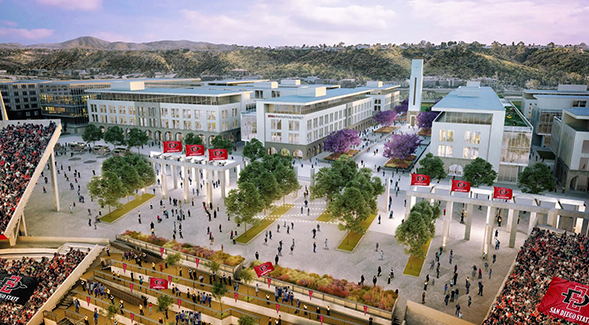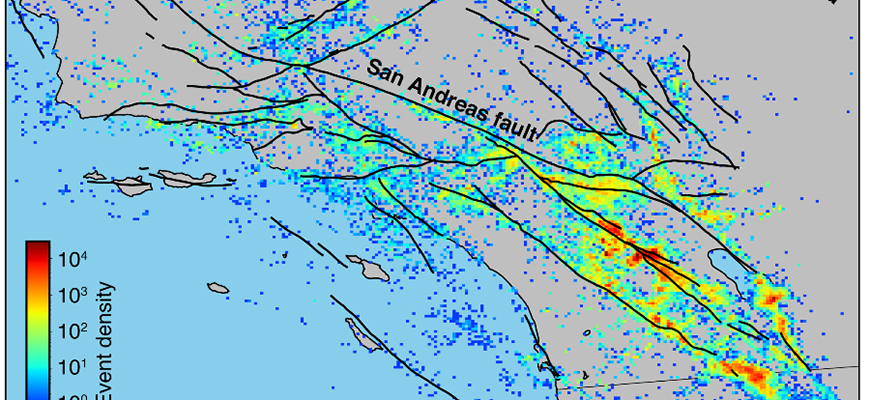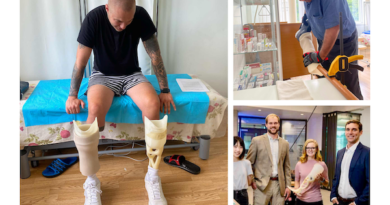Daily Business Report-April 19, 2019
New mapping of earthquake density reveals hundreds of thousands of small earthquakes. (Image: Science)
Scientists identify almost 2 million
previously “hidden” earthquakes
Poring through 10 years’ worth of Southern California seismic data with the scientific equivalent of a fine-toothed comb, seismologists from Scripps Institution of Oceanography and colleagues have identified hundreds of thousands of previously unidentified tiny earthquakes that occurred between 2008 and 2017.
The study, published in the journal Science on April 19, expands the earthquake catalogue for that region and period of time by a factor of 10—growing it from about 180,000 recorded earthquakes to more than 1.8 million. The new data reveal that there are about 495 earthquakes daily across Southern California, occurring at an average of roughly three minutes apart—a much faster rate than seen in previous catalogs.
This tenfold increase in the number of recorded earthquakes represents the cataloguing of tiny temblors, between magnitude 1.7 and 2.0, made possible by the broad application of a labor-intensive identification technique that is typically only employed on small scales. These quakes are so small that they can be difficult to spot amid the background noise that appears in seismic data, such as shaking from automobile traffic or building construction, for example.
“It’s not that we didn’t know these small earthquakes were occurring. The problem is that they can be very difficult to spot amid all of the noise,” said Zachary Ross, lead author of the study and a postdoctoral scholar in geophysics at Caltech.
Ross collaborated with Egill Hauksson, research professor of geophysics at Caltech, as well as Daniel Trugman of Los Alamos National Laboratory and Peter Shearer of Scripps, who applied a high-resolution approach to locate the newly discovered events. The work was supported by the National Science Foundation and the U.S. Geological Survey.
___________________
$95.3 million in renovations completed
at Tijuana International Airport
Cross Border Xpress and Grupo Aeroportuario del Pacifico announced the completion of a $95.3 million renovation at the Tijuana International Airport (TIJ). The renovation features upgrades to terminal infrastructure and technologies as well as consumer-facing areas such as expanded check-in desks, security checkpoints and baggage claim.
The project, which has been underway for the past five years, marks the largest investment made by and Grupo Aeroportuario del Pacifico to date. Upgrades include the modernization and extension of the main terminal building. Airport infrastructure improvements include a new turbo pipeline to supply and service aircraft more efficiently, as well as expanded aircraft parking positions to improve the boarding process.
“The investments were made to accommodate the immense increase in passenger traffic that Cross Border Xpress has brought to Tijuana International Airport,” said Eduardo González Pérez, administrator of the airport. “Since Cross Border Xpress opened in 2015, we’ve seen a cumulative growth of more than 60 percent.”
Additional renovation features include: new check-in area with 12 additional counters;
five new baggage claim belts with extended capacity; new security check point with two lanes for CBX passengers; a total of 91,493 square feet of expanded space and 182,986 square feet of renovated space.
___________________

Gensler selected as architect for SDSU’s
proposed stadium for Mission Valley
Gensler has been selected as the architect for San Diego State University’s proposed new multi-use stadium in Mission Valley. The design firm will work alongside Clark Construction, which was selected earlier this year as the design-build contractor for the expandable 35,000-capacity stadium.
As proposed, the new multi-use stadium will support collegiate football, professional and collegiate soccer, NCAA championships, concerts and other events. In keeping with the current timeline, if approved, construction is slated to begin in early 2020 with a completion date in time for the start of the 2022 NCAA football season.
Clark Construction and SDSU went through a joint selection process to choose Gensler. The final selection was announced to bidders on Wednesday.
The design and planning for the proposed new stadium is taking place concurrent with the university’s negotiations with the city of San Diego to purchase the land, and the preparation of the Draft Environmental Impact Report (DEIR) for the complete SDSU Mission Valley development. The university anticipates the draft EIR will be out for public review this summer and the California State University Board of Trustees is expected to consider its approval at their first meeting in 2020.
In addition to the new stadium, SDSU Mission Valley will be the location of a campus expansion, which will include a world-class university research and innovation district, a community river park and housing.
___________________

Health care providers play a role
in bipartisan gun legislation
Dan Morain | CALmatters
Remember when the National Rifle Association tweeted that doctors should “stay in their lane” and not take stands on gun control, and physicians answered by detailing their experiences treating the impact of gun violence with the #ThisIsOurLane campaign?
Now, legislation gaining bipartisan support would put into law how doctors, nurses and other health professionals might help avert gun violence.
Democratic Assemblyman Marc Berman of Palo Alto, the bill’s author, argues that “health care providers are uniquely positioned to help prevent firearm-related harm.”
The concept predates the NRA vs. physicians twitter fight. But it would require that the state-funded University of California Firearm Violence Research Center in Sacramento develop information that physicians and other health providers could use to identify patients who are at risk for shooting themselves or others, and intervene.
Some of the information exists here.
Dr. Garen Wintemute, the center’s founder and director, pointed out that patients often visit doctors when they’re depressed or suffering from substance abuse. Those visits, he said, can offer a “teachable moment.”
His goal: “We’re going to change the practice of medicine and the profession of nursing and other health professionals when it comes to firearms.”
What’s next: The bill cleared its first committee with Republican support last week and faces its next hearing next Tuesday.
___________________
San Diego Continuing Education
to award $250,000 in scholarships
In academic year 2018-2019, San Diego Continuing Education (SDCE) presents $250,000 in scholarships and awards to over 150 students at the 11th annual “Stars on the Rise” Scholarship and Awards Ceremony. The student achievement event, hosted by the SDCE Foundation, will take place on Monday, April 22, from 4 to 6 p.m. at the Jacobs Center for Neighborhood Innovation in southeastern San Diego (404 Euclid Ave., San Diego 92114, where 116 awardees will be recognized.
“This is the highest total amount of financial support ever awarded in the history of SDCE. Scholarships and awards are given to deserving students—many with plans to transition to career or college following their studies at SDCE based on academic merit, leadership and service to the community,” said SDCE President Carlos O. Turner Cortez.
___________________
New study targets Achilles’ heel of
pancreatic cancer, with promising results
Advanced pancreatic cancer is often symptomless, leading to late diagnosis only after metastases have spread throughout the body. Additionally, tumor cells are encased in a “protective shield,” a microenvironment conferring resistance to many cancer treatment drugs. Now, Salk Institute researchers, along with an international team of collaborators, have uncovered the role of a signaling protein that may be the Achilles’ heel of pancreatic cancer.
The findings, published in Nature on April 17, 2019, show that pancreatic stellate cells—resident cells typically dormant in normal tissue—become activated and secrete proteins to form a shell around the tumor in an attempt to wall off and contain it. The activated stellate cells also secrete a signaling protein called LIF, which conveys stimulatory signals to tumor cells to drive pancreatic cancer development and progression. Results also suggest LIF may be a useful biomarker to help diagnose pancreatic cancer more quickly and efficiently.
___________________

Prescription Drug Take Back Day to be held April 27
San Diegans will once again have an opportunity to get rid of unused or unwanted medications during the Drug Enforcement Administration’s spring Prescription Drug Take Back Day April 27.
The Take Back Day will take place from 10 a.m. to 2 p.m., Saturday, April 27. San Diegans can dispose of their medications anonymously, and there’s no charge. Call (800) 882-9539 or go to www.deatakeback.com.
___________________

County participates in Earth Day
and Earth Day events around region
The County of San Diego will take part in Earth Day and earth-friendly events around the county to share how the county protects the environment—from improving air quality to protecting watersheds and diverting waste from landfills—and explain how residents can help.
Those events will include a County Earth Day Fair to be held from 11 a.m. to 2 p.m. Monday, April 22 at the County Operations Center at 5500 Overland Ave. in San Diego, and participation in EarthFair 2019, Sunday, April 28 in Balboa Park.
Monday’s County Earth Fair, which is free and open to the public, will be held in the main plaza of the County Operations Center. There will be informational booths and displays, environmental swag, activities, prizes and a recycling collection event for batteries and compact fluorescent lights (no tube lights).
Some of the other earth-friendly events County departments will be taking part in include:
EarthFair 2019: 10 a.m. to 5 p.m. Sunday, April 28, Balboa Park, San Diego. The annual event expects to draw more than 60,000 visitors and feature more than 300 exhibitors, including the County’s Parks and Recreation Department, Air Pollution Control District and the Department of Public Works, which will team up with the cities of San Diego and Chula Vista to hold the “Reuse and Repair Fair.”
I Love a Clean San Diego’s 17th Annual Creek to Bay Event: 9 a.m. to 12 p.m. Saturday, April 27. The County is one of the many sponsors of the event. Last year, more than 6,400 volunteers collected more than 72 tons of trash and debris from 116 sites. Register at I Love a Clean San Diego’s website.
Spring Garden & Butterfly Festival: 9 a.m. to 3 p.m. Saturday, April 27 at the Garden, located at 12122 Cuyamaca College Drive, El Cajon. County contractor, the Solana Center, will host informational booths about composting.
Arbor Day Plant a Tree: 10 a.m. to 12 p.m., Friday, April 26, Flinn Springs County Park, 14787 Olde Highway 80, El Cajon. ($3 parking fee) The County Parks department wants to help you celebrate Arbor Day by planting native tree seedlings.
Earth Day Bird Watching: 1:30 p.m. to 2:30 p.m. Saturday, April 20, Lake Morena County Park, 2550 Lake Morena Drive, Campo. ($3 parking fee) Join a County park ranger for a bird-watching hike along the shore of Lake Morena. Learn about diverse bird species while watching rare birds fly through the trees and along the water to hunt for food.



